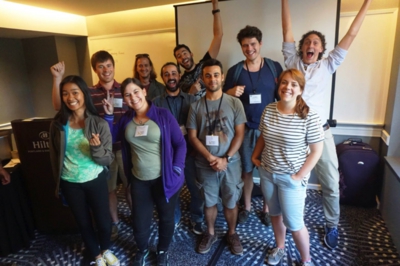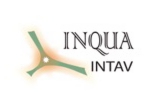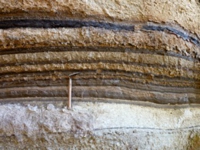News
Report of the INTAV meeting
"Tephra Hunt in Transylvania", Romania, 2018
In detail, go to Top.
Conference proceedings: a special issue on tephrochronology in Quaternary International
An editorial team is working on a *Quaternary International* Special Issue on tephrochronology “Crossing New Frontiers” that was discussed at the INTAV business meeting in Romania. We requested people’s interest in submitting a manuscript during the registration process and have contacted anyone who expressed an interest. However, if you did not express an interest or were unsure at the time, and are now inspired to submit a paper, you have not missed out on the opportunity (i.e. we are happy to receive additional papers centred on tephrochronology from colleagues who were not at the conference in Moieciu de Sus). If you wish to contribute please could you contact Peter Abbott at Abbottp@cardiff.ac.uk as soon as possible. As announced at the meeting we would request initial manuscript submission by 31st December 2018. This deadline must be adhered to so that we can anticipate the special issue being published in 2019.
Announcement of a job opportunity working on a tephra database project at Concord University
Dear friends of tephra,
The US National Science Foundation has funded for a 1-year pilot the EarthCube Integration project THROUGHPUT: Standards and Services for Community Curated Repositories. This project aims to link together multiple data repositories which host, for example, information on paleoecology, lake cores, marine cores, geochemistry, geologic samples, tephra deposits, etc. Tephra is a key science use case on this project, and Throughput will thus serve as a significant step on the way toward developing a globally-integrated system for tephra data. We have funding to hire a M.S. or Ph.D. level research data technician to work with partner tephra laboratories & research groups to incorporate tephra data into open access repositories. The desired start date for this position is January 2018.
An advertisement for the position is available here:
https://www.indeed.com/viewjob?t=research+data+technician&jk=119afb4780bb7397&_ga=2.139858547.1934626546.1508336419-102207104.1500917288
and
http://www.concord.edu/sponsored-programs/node/17
Please share this with any potential candidates with whom you may be familiar.
Thanks for your help.
- Steve Kuehn
Tephra workshop, Portland
Close to 60 participants took part in the INTAV-led tephra workshop on Saturday 19 August, 2017, in Portland, Oregon, USA, and comprised a combination of tephrochronologists, volcanologists, analytical geochemists, and database specialists. Organised and facilitated very capably by Kristi Wallace, Steve Kuehn, Marcus Bursik, and Andrei Kurbatov, the workshop was entitled “Best Practices in Tephra Collection, Analysis, and Reporting: Leading Toward Better Tephra Databases”. It followed an impressive IAVCEI volcanology conference in Portland the preceding week.
The tephra workshop was funded in part by a ‘skill enhancement’ grant (1710P) from the International Union for Quaternary Research (INQUA) made to the International focus group on tephrochronology and volcanism (INTAV) through INTAV’s ‘host’ commission in INQUA, the Stratigraphy and chronology commission (SACCOM). The grant enabled 10 early career researchers (ECRs) (pictured) to be awarded travel grants to help enable them to attend the meeting.

The workshop, which followed an earlier event in Portland in 2014 (https://vhub.org/groups/tephra2014), targeted several objectives of the current EXTRAS project (2015-19): EXTending tephRAS as a global geoscientific research tool stratigraphically, spatially, analytically, and temporally. EXTRAS is being achieved through 7 objectives, in brief as follows:
1. Mapping and stratigraphy (range of scales)
2. Characterisation
3. Dating/age modelling
4. Correlation
5. Databases
6. Capability
7. Outreach
The workshop comprised a mixture of talks over a wide range of topics, most being short and to the point by specialists in various subdisciplines, together with discussion sessions. As well as delving into aspects of topics 1 to 6 above, recent advances and new ways of detecting and identifying tephras and cryptotephras were reported. The main goals of the workshop were to advance both tephrochronology and volcanology, in keeping with the theme for the IAVCEI meeting “Fostering integrative studies in volcanism”. All in all, the meeting was a great success in bringing together a mix of experience and youth as well as specialists from multiple disciplines, and the discussions will lead to further advances. An overview from the meeting is available on the VHUB volcano website (please become a member of VHUB): https://vhub.org/groups/tephra2017workshop A notably high level of enthusiasm was sustained through the day and after, which is very heartening indeed for the discipline of tephrochronology.
Update from INTAV
We are delighted to advise that Prof Siwan Davies (Swansea University, UK; former president of INTAV 2007-2011) has agreed to return as one of three vice-presidents of INTAV through to the next full INQUA congress in Dublin, 2019. Siwan replaces Dr Victoria Smith, who resigned from the executive some time ago after many years of service to INTAV.
Special issue of Quaternary Geochronology: issued May 2017 as volume 40
Following the two successful tephra-based sessions held at the full INQUA congress in Nagoya in 2015, a special tephra-focussed issue of Quaternary Geochronology has been developed with around a dozen papers currently in various stages of review. It is planned to complete the volume this year.
The special issue is provisionally entitled “Advancing tephrochronology as a global dating tool: applications in volcanology, archaeology, and palaeoclimate research”.
Guest editors are Christine Lane (lead), Takehiko Suzuki, Victoria Smith, David Lowe, and Simon Blockley.The issue follows on the heels of a number of recent tephra conference sessions and workshops held over the last two years, which have witnessed important methodological advances in, and broad-ranging applications of, tephrochronology, being carried out by members of the Quaternary tephra community from around the world. The issue follows on the heels of a number of recent tephra conference sessions and workshops held over the last two years, which have witnessed important methodological advances in, and broad-ranging applications of, tephrochronology, being carried out by members of the Quaternary tephra community from around the world. The issue follows on the heels of a number of recent tephra conference sessions and workshops held over the last two years, which have witnessed important methodological advances in, and broad-ranging applications of, tephrochronology, being carried out by members of the Quaternary tephra community from around the world. Quaternary Geochronology aims to communicate the latest developments and applications in both traditional and emerging Quaternary dating methods, however it has not to date developed a strong profile in Quaternary tephrochronology publications (with some excellent exceptions of course). This is an opportunity therefore to present a package of excellent tephra research papers, with a distinct chronological focus, to a wide and international audience, meanwhile underlining the role of tephrochronology as a powerful Quaternary dating technique across volcanology, archaeology, palaeoclimate and geohazard research
The issue follows on the heels of a number of recent tephra conference sessions and workshops held over the last two years, which have witnessed important methodological advances in, and broad-ranging applications of, tephrochronology, being carried out by members of the Quaternary tephra community from around the world.
Quaternary Geochronology aims to communicate the latest developments and applications in both traditional and emerging Quaternary dating methods, however it has not to date developed a strong profile in Quaternary tephrochronology publications (with some excellent exceptions of course). This is an opportunity therefore to present a package of excellent tephra research papers, with a distinct chronological focus, to a wide and international audience, meanwhile underlining the role of tephrochronology as a powerful Quaternary dating technique across volcanology, archaeology, palaeoclimate and geohazard research.
INTAV continues as IFG of INQUA 2015-2019
In mid-April 2016, we heard that the INQUA Executive approved INTAV as an International Focus Group (IFG) for the intercongress period 2015-2019. This decision attests to our recognition as a strong research community that has achieved much over the past years and allows us to apply for funding to support an intercongress conference on tephrochronology, and other meetings.
In preparing a detailed proposal in December 2015, the executive of INTAV argued that (1) tephra studies (tephrochronology sensu lato) are one of the clearest examples of inter-environmental and inter-disciplinarity working that exists in the geoscience community today, and (2) that the diversity of our discipline renders it a necessity that we have a core working community – INTAV – to exchange ideas and identify and enhance common practices. INTAV as an IFG has been both a driver and vehicle for one of the major avenues for the advancement of Quaternary science in recent times: developments in the science, methodology, and application of tephrochronology.
Wide international support for INTAV as a renewed IFG for 2015-2019 (and hopefully beyond to 2013) was therefore very strongly endorsed by members and supporters: 114 named members plus numerous members of six named international research projects (e.g. INTIMATE, SMART, CELL50K, SHAPE), members of the Vhub collective, and the presidents of all five INQUA commissions, SACCOM, CMP, TERPRO, PALCOMM, and HABCOM, all supported the continuation of INTAV. The encouragement and support of Mauro Coltorti, president of SACCOM, for the INTAV bid is warmly acknowledged.
Recent conferences
Tephra sessions successfully held at INQUA Congress in Nagoya, Japan, 27 July-2 August 2015
The INTAV executive through SACCOM and other commissions convened two tephra-focussed sessions in Nagoya: (1) session SO5 “Studies on tephras and cryptotephras and their use as isochrons in palaeoenvironmental and palaeoclimatic reconstructions”, and (2) session SO4 “Tephras and cryptotephras and their use in studies of natural hazards and archaeology”. A total of 49 papers (23 oral and 26 posters) were presented. Three lead speakers (keynotes) were: Peter Abbott (UK) “Tracing North Atlantic tephras 25-8 ka”, Christine Lane (UK) “Tephrostatigraphy of East Africa”, and Brent Alloway (NZ) “Tracing earliest hominins in SE Asia using tephrochronology”.
The INTAV executive will held a business meeting at the end of the tephra session (see JISCMail ‘Tephra’).
Other meetings
Tephra sessions were held at theAGU Fall Meeting in December 2014 at the inaugural African Quaternary Association meeting in February 2015. The AGU session, ‘Exploiting the Potential of Tephra in Paleoenvironmental Records’, was convened by Karen Fontijn, Maarten Van Daele, Paul Hughes and David Pyle, and the invited speakers were Siwan Davies, Emma Gatti, and Victoria Smith. The AFQUA session was titled “Dating and correlation of African archives of environmental change and archaeology” and was convened by Christine Lane, Abigail Stone and Simon Armitage.
A specialist meeting - “Tephra 2014: Maximising the potential of tephra for multidisciplinary science” – was held in Portland, Oregon, USA, in early August 2014. Convened by Marcus Bursik and Solene Pouget (University at Buffalo, USA), and Steve Kuehn (Concord University, USA), the 4-day workshop discussed major developments, best practices, and future directions/needs in tephra studies from the perspectives of volcanology, tephrochronology, and Quaternary sciences. At the conference, a tephra data working group began to explore ways to increase the discoverability and accessibility of tephra data to enhance tephra research and interdisciplinary collaboration. INTAV members and others attended the AGU Fall Meeting in San Francisco in December, 2013, where sessions included the geochronology, correlation, and climatic significance of widespread volcanic ash layers. At this meeting, Steve Kuehn (Concorde University, USA) also presented a paper on developing an integrated global tephra database as part of a symposium on data-driven science in geochemistry, petrology, and volcanology.
In August 2013, Duane Froese (University of Alberta, Canada) convened a symposium on tephra studies at the joint Canadian Quaternary Association (CANQUA) and Canadian Geomorphology Research Group (CGRG) conference in Edmonton, Alberta. Around a dozen tephrochronologists from Canada, USA, UK, Italy, and New Zealand presented papers including a keynote paper by Christine Lane (Oxford University, UK) on cryptotephras as a dating and correlational tool in archaeology.
In July 2013, the IAVCEI meeting in Kagoshima, Japan, included numerous papers relating to explosive volcanism and tephras, and numerous fields were run including a trip to see the products of recent volcanism in Kamchatka led by Vera Ponomareva (Institute of Volcanology and Seismology, Russia).
Specialist INTAV meetings
In addition to specialist workshops INTAV members organise field-based tephra conferences from time to time, the most recent being the ‘Active Tephra’ conference in Kirishima, southern Kyushu, Japan, in May, 2010. Previous conferences (since the early 1990s) of SCOTAV and COT have been held in the Yukon Territory, Canada (2005), southern France (1998), New Zealand (1994), and western USA (1991). INTAV also organises tephra based symposia at INQUA congresses and those of other organisations such as the International Association of Volcanology and Chemistry of the Earth’s Interior (IAVCEI).
Others
Passing of Valerie Hall (1946-2016)
Professor Emerita Valerie Hall died in 2016 in Belfast after a long battle with cancer. Valerie was a highly esteemed inter-disciplinarian, who began her career in botany and palynology but made a truly international mark in helping to develop cryptotephra studies. With close colleagues and students she helped develop new techniques for extracting sparse glass shards from peat bogs in Ireland and elsewhere and applying them to a range of Quaternary palaeoenvironmental reconstructions and archaeological problems. She also helped train and mentor a generation of new tephrochronologists. INTAV made Valerie an Honorary Life Member in recognition of her outstanding contributions to tephrochronology and to teaching and mentoring.
An obituary is available at G. Plunkett et al. (2017), Quaternary Geochronology (in press),http://dx.doi.org/10.1016/j.quageo.2016.09.005






